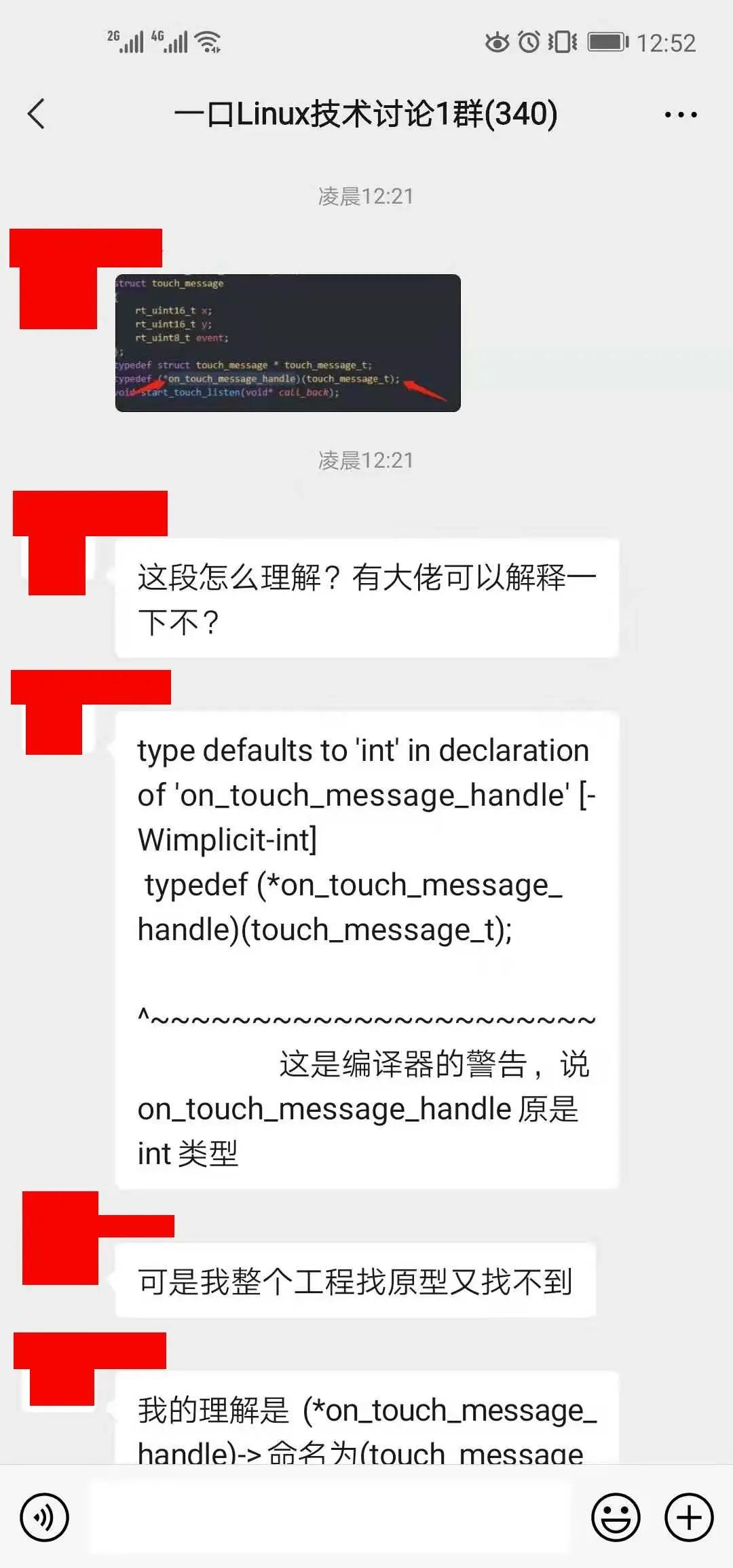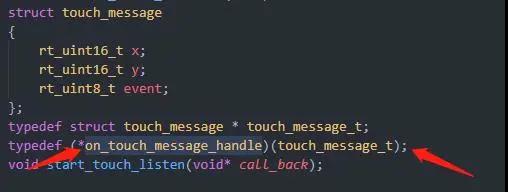函數指針定義的一個錯誤
1. 問題
粉絲提問:某個函數指針的使用:編譯時出錯了。
type defaults to 'int' in declaration of 'on_touch_messgae_handle'[-Wimplicit-int] typedef(*on_touch_messgae_handle)(touch_message_t);
粉絲源碼如下:
2. 分析
1) 結構解析
- 1 struct touch_message
- 2 {
- 3 rt_uint16_t x;
- 4 rt_uint16_t y;
- 5 rt_uint8_t event;
- 6 };
- 7 typedef struct touch_message * touch_message_t;
- 8 typedef (*on_touch_messgae_handle)(touch_message_t);
首先看下7行這個類型定義:
- typedef struct touch_message * touch_message_t;
定義后
- touch_message_t
等價于
- struct touch_message *
就是說我們如果用touch_message_t 定義的變量是一個struct touch_message類型的一個指針。
再來分析下8行這個定義:
- typedef (*on_touch_messgae_handle)(touch_message_t);
可以替換成下面這個定義
- typedef (*on_touch_messgae_handle)(struct touch_message *);
2) 分步解析
有的C語言基礎不是很好的朋友,可能無法一眼看出來這個定義, 為了讓新手更容易看懂,我們來看一下下面一個遞進式的定義:
- int fun;
這是一個整型變量fun;
- int fun();
這是一個函數fun, 參數 :空 返回值:int型
- int fun(struct touch_message *);
這是一個函數fun, 參數 :struct touch_message *的一個指針 返回值:int型
上述的變化都好理解,下面我們將fun做如下修改:
- int (*fun)(struct touch_message *);
括號的優先級最高,(fun)一旦如此定義,那么fun就要先和結合, 所以fun變成了一個指針,
那么該指針指向什么呢?就需要看外面是如何定義的, 右邊是(struct touch_message * ),左邊是int, 所以說明指針指向的是一個函數,
參數 :struct touch_message *的一個指針 返回值:int型
舉例:將函數my_fun賦值給函數指針fun。int my_fun(struct touch_message *) { } int (*fun)(struct touch_message *); fun = my_fun;
這里有一個隱藏的知識點,函數名其實也是一個地址,而且賦值的時候函數類型必須和函數指針類型一致。
- typedef int (*fun)(struct touch_message *);
如果左邊再加上typedef呢?相當于是設置fun為新的類型,我們可以用fun來定義一個函數指針, 該函數類型同上。
舉例 用新的類型定義一個函數指針變量,并給他賦值。typedef int (*fun)(struct touch_message *); int my_fun(struct touch_message *) { } fun fun_ptr; fun_ptr = my_fun;
然后將參數修改為,touch_message_t,就得到了粉絲的源碼中的樣子,
- typedef int (*fun)(touch_message_t);
但是粉絲的源碼中定義的函數類型缺少了對函數返回值的描述,所以左側增加一個int或者其他類型即可即可。
3. 函數指針
函數指針在linux內核中使用非常頻繁,
比如字符設備,內核給多有的字符設備提供了一個統一的接口,我們對設備的所有操作被抽象成read、write、open、close等,并封裝到結構體struct file_operations 中:
- struct file_operations {
- struct module *owner;
- loff_t (*llseek) (struct file *, loff_t, int);
- ssize_t (*read) (struct file *, char __user *, size_t, loff_t *);
- ssize_t (*write) (struct file *, const char __user *, size_t, loff_t *);
- ssize_t (*aio_read) (struct kiocb *, const struct iovec *, unsigned long, loff_t);
- ssize_t (*aio_write) (struct kiocb *, const struct iovec *, unsigned long, loff_t);
- int (*iterate) (struct file *, struct dir_context *);
- unsigned int (*poll) (struct file *, struct poll_table_struct *);
- long (*unlocked_ioctl) (struct file *, unsigned int, unsigned long);
- long (*compat_ioctl) (struct file *, unsigned int, unsigned long);
- int (*mmap) (struct file *, struct vm_area_struct *);
- int (*open) (struct inode *, struct file *);
- int (*flush) (struct file *, fl_owner_t id);
- int (*release) (struct inode *, struct file *);
- int (*fsync) (struct file *, loff_t, loff_t, int datasync);
- int (*aio_fsync) (struct kiocb *, int datasync);
- int (*fasync) (int, struct file *, int);
- int (*lock) (struct file *, int, struct file_lock *);
- ssize_t (*sendpage) (struct file *, struct page *, int, size_t, loff_t *, int);
- unsigned long (*get_unmapped_area)(struct file *, unsigned long, unsigned long, unsigned long, unsigned long);
- int (*check_flags)(int);
- int (*flock) (struct file *, int, struct file_lock *);
- ssize_t (*splice_write)(struct pipe_inode_info *, struct file *, loff_t *, size_t, unsigned int);
- ssize_t (*splice_read)(struct file *, loff_t *, struct pipe_inode_info *, size_t, unsigned int);
- int (*setlease)(struct file *, long, struct file_lock **);
- long (*fallocate)(struct file *file, int mode, loff_t offset,
- loff_t len);
- int (*show_fdinfo)(struct seq_file *m, struct file *f);
- };
那么我們應該如何定義該結構體變量并初始化呢?
- static struct file_operations hello_ops =
- {
- .open = hello_open,
- .release = hello_release,
- .read = hello_read,
- .write = hello_write,
- };
函數定義如下:
- static int hello_open (struct inode *inode, struct file *filep)
- {
- return 0;
- }
- static int hello_release (struct inode *inode, struct file *filep)
- {
- return 0;
- }
- static ssize_t hello_read (struct file *filep, char __user *buf, size_t size, loff_t *pos)
- {
- return size;
- }
- static ssize_t hello_write (struct file *filep, const char __user *buf, size_t size, loff_t *pos)
- {
- return size;
- }
注意,函數的參數和返回值,必須嚴格按照結構體struct file_operations中的類型定義。【編輯推薦】

































